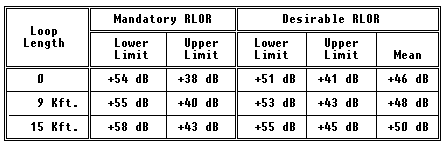| RETURN | Voice Networking |
Telephones
The common POTS (Plain Old Telephone System) telephone;
– Requests service from the network.
– Performs dialing functions.
– Performs a notification function (ringing).
– Provides Answer and Disconnect supervision.
– Converts speech signals to electrical signals and vice versa.
– Automatically adjusts to supplied power.
Telephone Off-Hook Supervision
Two conductors connect the telephone to the switch. The telephone uses a signaling method known as Loop Start. When the phone is off-hook, current flows through the 2 conductors (2-Wire) that connect the phone the the network. If the phone is in an on-hook state, no current flows, as indicated in the following diagram.

When initiating a call, the telephone is placed off-hook. The connected network switch senses the off-hook condition (current flow) and provides an audible Ready signal known as ‘Dial Tone’:

The user must then request connection to another telephone by transmitting the address (Called Party Identification number) of the requested telephone to the network.
Telephone Address Supervision
When address signaling is performed, the telephone can utilize two types:
– Pulse Dial (Rotary)
– Dual Tone Multi-Frequency – “DTMF” (Tone)
– Optionally, a signaling method called Multi-Frequency (MF) can be used.
Pulse Dialing
The following diagram depicts Pulse Dialing operation:

Within the US, EIA Standard RS-470 details the specifications for pulse dialing. In general, the pulse repetition rate must be between 8 and 11 pulses per second (PPS). The exact allowable range is dependent upon the type of capacitance used in the telephone’s protective network.
The Percent Break (the % of time that a Break state is maintained within a pulse) can be in the range of 58% to 64% (61% nominal), depending upon the type of Zener diode breakdown voltage used within the telephone’s protective network. Assuming a PPS rate of 10, a the nominal length of the Break time will be 61 mS.
Note: The “0” key (dialing “)”) will output 10 pulses, taking approximately 1 second to transmit (at 10 PPS). The “5” key will take approximately 1/2 second to transmit, etc.
‘Notes On The Network’ specifies dial pulse sender OBJECTIVES as listed in the following table:

However, older equipment could dial using ranges of 7.5 to 12 PPS and from 59.5% to 67.5% break. As such, digit receivers must be able to operate at greater ranges than the connected equipment. ‘Notes On The Network’ recommends that DP receivers ignore on-hook (break) signals less than 10 mS and accept on-hook signals greater than 25 mS.
In old Step-By-Step systems, the end of a digit is recognized when the off-hook signal exceeded 90 to 295 mS. Newer systems recognize the end of a digit in off-hook detection ranges of 70 to 210 mS.
The interdigit time is the time between output digits. This can be as low as 300 mS for modern systems, with 700 mS recommended for older Step-By-Step systems. Typically, senders do not have interdigit delays less than 500 mS, however. In EIA RS-470, the requirements for interdigit delays are specified for equipment using automatic dialing (“senderized” dialing). The first digit is to be outpulsed between 70 mS and 10 seconds after receipt of dial tone. The minimum interdigit interval is specified as 600 mS, with 700 mS recommended. The maximum interdigit interval is specified as 3 seconds, with 1 second being the recommended maximum interval.
DTMF Dialing
The most commonly used signaling system today is DTMF (Dual Tone Multiple Frequency) signaling. This signaling consists of two tones, combinations of which are transmitted, depending upon upon the signaling digit. The following matrix describes the tone pairs used.
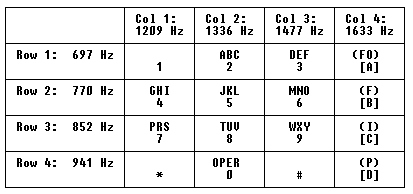
For most systems, only columns 1-3 are used, providing 12 possible signaling states. Except where denoted with parenthesis () or brackets [], the lettering above the digit number appears on standard telephone handsets.
Within the North American phone system, BOCs often support the use of the octothorpe (#) to end the Interdigit Timeout period. This allows calls to be processed faster if the dialing digits are immediately followed by the “#” Stop-Dial signal. When the # is the first digit in a dialing sequence, this notifies the switch of a call requiring special treatment, such as a data call.
The digits in brackets (A-D) indicate the additional fourth column of DTMF signaling, allowing a total of 16 possible digits. The U.S. Government’s AUTOVON network uses these digits (A-D) to represent call priorities of Flash Overide (A), Flash (B), Immediate (C), and Priority (D), respectively. AUTOVON calls placed without using these digits are treated as Routine (normal) priority.
EIA RS-470 specifies that DTMF generators utilize the following levels:
Per Frequency : -6 dBm to – 4 dBm
Per Frequency Pair : +2 dBm
The frequency components must be within ñ 1.5% of their nominal values.
For automatic dialing (‘senderized’), the minimum digit cycle time is specified as 100 mS. The duration of the DTMF signal must be at least 50 mS, and the mimimum interdigit interval is specified as 45 mS. The maximum interdigit interval is 3 seconds.
‘Notes On The Network’ advises that DTMF receivers should register digits with on-times as short as 40 mS. While there is no requirement to bridge a gap in the DTMF tone, the DTMF receiver must recognize 40 mS of no tone as an interdigit interval. It should be noted that some receivers may recognize 20 mS of no tone as an interdigit interval.
The DTMF receiver must detect DTMF digits in a range of -25 to 0 dBm, per frequency. Typically, ‘senderized’ DTMF digits from a switch are transmitted at a level of about -7 dBM0 per tone (-4 dBM0 per tone pair).
There are test tapes available, ‘Digit Simulation Test Tape for DTMF Receivers’ that can test for proper DTMF decoding.
Additionally, per EIA RS-470, the DTMF keypad on telephone sets must operate in presence of either normal or reversed polarity. IT SHOULD BE NOTED THAT OLDER TELEPHONE SETS MAY BE SENSITIVE (NON-FUNCTIONAL) TO TIP, RING POLARITY REVERSAL.
Multi-Frequency Signaling
Multi-Frequency (MF) signaling is similar to DTMF, and is used on trunk circuits, pay telephones, and some CCITT signaling schemes (CCITT #5). Combinations of two tones are used to transmit signaling information, as indicated in the following chart:
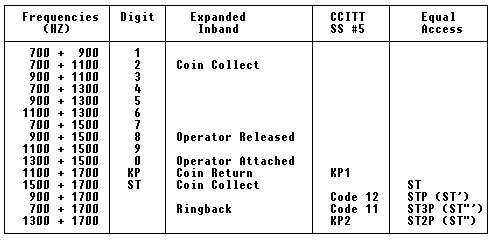
The KP (*) digit is a Start-Dial signal, used in some CCITT Signaling methods (e.g. R1 and R2 signaling). When the * is the first digit, (in the form of *XX or *XXX), it is used to notify the switch that the following digits represent a specific feature or service.
The ST is a Stop-Dial signal, used in some CCITT Signaling methods such as R1 and R2 signaling.
ST2P is occasionally used in CCITT IDDD (International Direct Distance Dialing) trunks supporting MF signaling, and is referred to as the KP2 digit.
As per ‘Notes On The Network’, the level of each tone is specificed to be -7 dBm0 ñ 1 dB. Therefore, the level of the tone pair will be in a range of -3 to -5 dBm0.
MF receivers must recognize MF signals in the range of 0 to -25 dBm0 per frequency. It must be noted that some network equipment will only operate in the range of 0 to -22 dBm0.
When MF tones are transmitted, the length of the tone (ON) should between 61 and 75 mS (with an average of 68 mS). The nominal OFF period is 60 mS in duration. The length of KP is 90 to 120 mS.
Call Progress Indicators
The network uses a variety of audible tones, known as Call Progress Indicators, to indicate specific conditions to the user:
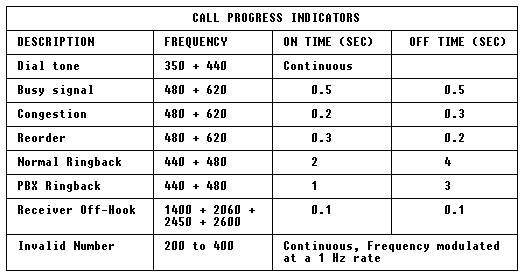
A Precise Tone Plan is used in 1/1AESS, 2/2BESS, 3ESS, 4ESS, DMS-10 and DMS-100 switches. This plan uses four precise tones which are held within ñ 1.5 dB level and ñ 0.5% frequency ranges. The frequencies supported are:
350 Hz
440 Hz
480 Hz
620 Hz
Some precise Call Progress Indicators:
Dial Tone: 13 dB per frequency, 10 dB frequency pair
Reorder, Busy, No circuit: 24 dB/frequency, 21 dB/pair
Ringing: 19 dB/frequency, 16 dB/pair
Answer and Incoming Call/Ringing Supervision
When a telephone set is called, the network switch will generate a Ring Voltage to the phone. The connected switch will superimpose a Ring Voltage of approximately 90 VAC over the DC voltage. A capacitor in the phone allows the passage of AC current, but blocks DC current. Upon detection of the Ring Voltage, the phone will provide an audible signal that alerts the user of an incoming call.
Ring Voltage provided is between 90 and 140 Volts, Alternating Current and has a frequency in the range of 15.3 to 68 Hz. Typically, a frequency of 20 Hz is implemented. The Ring Voltage is sent at a rate of 1 second ON and 3 seconds
OFF within Europe; and 2 seconds on, 4 seconds off in the U.S. In the U.K., the typical cadence is 0.4 seconds on, 0.2 seconds off, 0.4 seconds on, and 2 (two) seconds off:
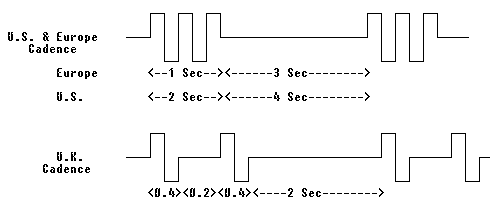
Each telephone set provides a Ringer Equivalence Number (REN), as defined within FCC Part 68 and RS-470. Some examples of RENs are:
1A
1.5A
0.5B
2L
etc.
The REN is used to ensure that the central office can provide the correct amount of power required to ring the telephone set. As ringers are added to the circuit without additional power supplied (overload), the voltage will drop to a point at which the telephone ringer(s) will not operate properly. The REN is expressed in units and tenths, then followed by a letter. The letter describes the Frequency Range, Power Range, and Bias (VDC) range of the telephone set. These letter designations are further explained in EIA RS-470.
For the U.S. Public Switched Telephone Network (PSTN), the REN letter must be either ‘A’ or ‘B’.
When the phone is answered, DC current begins to flow in the loop. The Central Office senses the current flow and removes the superimposed Ringing Voltage.
MOST CENTRAL OFFICES IN THE PSTN CAN SUPPLY 4 TO 5 RENs PER LINE.
Network Announcements
Special tones and announcements are used to inform users of various conditions encountered on dialed calls. Announcements are preceded with Special Information Tones (SITs), which, as defined by CCITT, and described in “Notes On The Network”, use the frequencies of 950 Hz, 1400 Hz, and 1800 Hz. Usually following these SITs are prerecorded announcements. The format of these prerecorded announcements is described in ‘Notes On The Network’, Section 6.
Telephone Speech and Electrical Characteristics
As specified in EIA RS-470, the telephone has a Tip-To-Ring impedance of 600 ohms.
The efficiency of converting speech into electrical signals is defined as the Transmit Loudness Objective Rating (TLOR). Since the Objective Loudness Ratings represent loss, the more positive the number, the more loss presented. TLOR rating methods are specified in IEEE Standard 661-1979.
The following table describes the MANDATORY and DESIRABLE TLOR values for telephones:

Also, the efficiency of converting electrical signals into speech signals is defined as the Receive Loudness Objective Rating (RLOR). Since the Objective Loudness Ratings represent loss, the more positive the number, the more loss presented. RLOR rating methods are specified in IEEE Standard 661-1979.
The following table describes the MANDATORY and DESIRABLE RLOR values for telephones:
